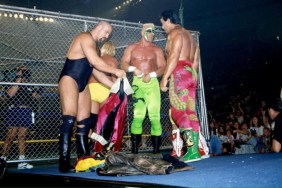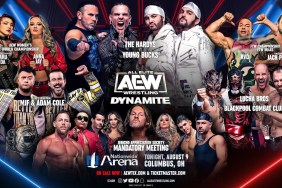Violence is one of the most ancient forms of entertainment. For whatever reason, humans have a hunger for bloodshed that has bred a constant flow of manifestations throughout the ages, all intended to bring enjoyment to the general populace. From gladiatorial battles to cockfights to jousting to boxing, over the centuries violence has been packaged differently to appeal to the audience of the time. Audiences once craved to see underlings devoured by a myriad of exotic animals, but at another stage longed to see glorified royals mount steeds and hurtle towards one another. As time passes, people desire for different stories told through brutality, and through this has bred the present type of this violence, pro wrestling.
Prowrestling is often dismissed as choreographed and fixed, because it is. Every match’s outcome is predetermined, and supposed nemeses converse professionally during their ‘epic struggles’. This can only be expected to draw a significant amount of skepticism from an already untrusting society. A society who thinks it maintains a firm hold on reality dismisses the childish and fictitious, the very same culture whose foundation is built on the ‘celebrity’ and the movie utopia Hollywood. Movies about time travel, imaginary lands, and historic conflicts make themselves at home at the box office. The idea of the ‘epic’ has always been a fascination of Hollywood, Ben Hur, Spartacus, and Gladiator are recognised as some of the classic films of the century, and have the academy awards to prove it. Each telling a story of the glorious battles fought in coliseums that bred real men through violence. The common audience sees these ancient heroes as the yardstick for what a man is supposed to be. And how couldn’t someone become overwhelmed by the sheer odds these warriors overcame each showing. However, it is now revealed the credibility of these champions is on par with that of Brock Lesnar.
A recent article suggests that gladiators weren’t pit in fights to the death, but instead were the Hulk Hogans and Lex Lugers of their era. It’s speculated that gladiators were well paid and were recognizable ‘celebrities’ among the community, so well paid, that they were given salary caps, becoming investments for their owners, a la Don King. Supposing that these champions, who fought in the vicinity of three times a year, were so valuable, fighting to the death would be a waste of investment. So matches were designed so competitors could ‘win without wounding’, ensuring the biggest draws could continue to thrill fans.
Each match followed a simple three-step template to guarantee this outcome. The first stage was the initial contact between the two powerhouses, each fully armed and flailing attempted body shots. The second step involved one of the two participants being wounded and trying to retreat from the fray, the final stage consisting of both gladiators disarming and grappling. This simple procedure allowed for competitors to predict movements before they occurred, as to sustain realism and fluidity. It’s strange that an ancient method has found itself, relatively unchanged, being utilized in the future. Each WWE match you watch on television has the step one (the early tie-up, and struggle for power), the step two (the upper hand), and finally the step three (the chain of reversals). Although the WWE follows the same procedure, its gladiators are viewed as false, and not celebrated like their Roman counterparts.
What does this say about gladiatorial myths and legends, do they all now become bogus recounts of fictitious events. That’s one way that things could become, people dismissing ancient history because it isn’t what they thought it was. In that case, a whole chunk of our heritage will be rendered instantly non-existent. The other possibility is acceptance. Although we may feel lied to, gladiators still tell the same story they always did, the glorious conquests, and exotic foes. The morbid result of death seems to be a shame considering how much inspiration they brought the community. Heroes of an era. Just as a blonde-haired, mustached, yellow trunk adorned Adonis was the hero for the modern era.
Pro wrestling, like gladiators, tells a story of hope. A brash rookie staring into the face of an immovable object, and then going on to defeat it. A story of underdogs that inspires. Yet for all this our society sees contemporary gladiators as flamboyant fakes clogging airwaves and instilling false hopes in the youth of today. Discounting all credibility because the product is molded to achieve the optimal emotional effect in the viewer, a technique we now see has been used throughout history. Illustrating how audiences haven’t changed all that much over several millennia, still craving the same story of triumph.
There is one defining difference between Roman Empire professional wrestling and that of today, how the greater society views the sport. During the Roman Empire every person in a village, regardless of ranking in the social order, would come together in massive arena and enjoy sculpted demigods battling. It acted as an escape from the politics of life, and allowed them to be transported elsewhere, even if it was just for an afternoon. Conversely, today’s pro wrestling is met with scorn because it’s “fake”, when only a little over a decade ago it brought people together just as gladiators did thousands of years ago. The shining golden boy of the time was Hulk Hogan, a man who could seemingly do anything when he put his heart to it, but if he were to actually ‘shoot’ fight opponents such as Yokozuna, Andre the Giant, and The Undertaker, chances are he’d be flattened each match, and inevitably become seriously injured. What sort of hero would never be able to overcome obstacles, and simply return each week to get pummeled, the story would be depressing and hopeless. The family institution of pro wrestling wasn’t bred through reality but through telling a story of hope the audience could take home with them, and make them feel better about their lives.
Whether it is in a coliseum or a lounge room, pro wrestling has always been an escape from the treadmill of life. The fact that it is predetermined only makes the show entertaining and watchable, and now it’s been proven that pro wrestling isn’t a remotely new idea, older than the idea of a flushing toilet. In saying that, Vince McMahon and all the other promoters may not be original, but they knew worked and built on it. Two-minute shoot brawls don’t leave permanent memories in kids, sixty-minute classics telling a story of victory over odds do.
If you’d like to contact me with feedback or a question, shoot me an email at TheButchershopColumn@hotmail.com.
Over and Out
The Butcher
– – – – – – – – – – – – – – – – – – – – – – – –
If you are interested in becoming a columnist or simply love reading wrestling columns and would like to interact with the Column Staff here at WrestleZone please check out the Columns Lounge. Simply click HERE and you can take part in the fun today








